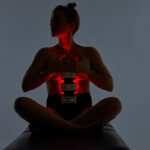Sunrises and sunsets are beautiful sights that evoke contemplative and philosophical moods, along with a warm feeling as the sunlight touches our faces. Beyond their aesthetic beauty, the red light in sunlight has healing and beneficial effects on our bodies. Science has revealed the advantages of red light therapy in healing and promoting well-being, offering solutions for various health issues such as muscle and joint pain, acne, sleep disorders, and even depression relief. With the convenience of home devices, red light therapy can be incorporated into our routines for enhanced health and wellness. Understanding the impact of sunlight on our health is crucial for harnessing its potential for our well-being.
Exploring the Benefits of Red Light Therapy:
Red light therapy utilizes specific frequencies, radiance density, and energy density to provide our bodies with the energy needed for self-healing and optimal functioning.
Understanding Red Light Therapy:
Red light therapy, also known as photobiomodulation, is designed to restore health and strength to the body, enabling it to repair itself and overcome environmental challenges. The advantages of red light therapy are astounding and encompass a range of benefits, including:
- Enhancing muscle endurance, tone, and density.
- Improving cognition and reducing the risk of dementia.
- Facilitating bone, tendon, and wound healing.
- Repairing damaged nerves.
- Promoting hair health and growth.
- Revitalizing skin by strengthening collagen networks.
- Boosting the immune system.
- Establishing effective connections with internal organs through the fascia.
- Hormone regulation.
- Aiding mood improvement and balance.
- Enhancing weight loss efforts.
The Mechanism Behind Red Light Therapy:
The underlying mechanism behind the benefits of red light therapy lies in our body’s natural electrical charge. Our bodies possess positive or negative charges on various levels, including membranes, proteins, and even DNA. Research has demonstrated that our bodies function like a large battery, with light being the force that charges us.
Red light helps heal and optimize the body by charging our mitochondria, the cell organelles responsible for energy production and signal transmission. When exposed to red light, mitochondria absorb the energy and increase their charge, thereby elevating the body’s energy levels.
Does Red Light Therapy Really Work?
Yes, red light therapy is indeed effective. It goes by many names, such as photobiomodulation (PBM), low-level laser therapy (LLLT), cold laser therapy, red infrared light therapy, and red LED light therapy, among others. As long as the light frequency falls within the range of 600 nm to 850 nm, it falls within the red and near-infrared light spectrum.
Red light therapy is a form of photobiomodulation supported by clinical research. A search for “red light therapy” on Google Scholar yields over 3,050,000 results, and adding “photobiomodulation” results in almost 15,000 hits, indicating extensive research in this field.
NASA has been investigating the potential of red light therapy since the 1980s, and interest in this non-invasive treatment has grown within scientific communities.
Studies indicate that photobiomodulation and low-level laser therapy, including red light therapy, offer non-invasive alternatives to other light-based treatments. They do not use ablation as a healing method, and the treated tissue’s temperature doesn’t rise. There’s no UV radiation involved, making it safe for the skin without causing sunburn.
Red light therapy can aid in pain relief, nerve injury soothing, and wound healing enhancement.
Applications of Red Light Therapy:
Red light therapy is beneficial for pain relief, recovery, and overall improvement. Pain relief through red light therapy is achieved by increasing blood flow, allowing endorphins to function more effectively. At the same time, the level of nitric oxide increases, improving pain management mechanisms.
Healing at the cellular level is due to mitochondria receiving the energy they need to expedite these processes. The energy from red LED light therapy is used to efficiently regenerate cells. Consequently, cells and tissues heal faster and better. For instance, wound healing is notably improved when employing red and infrared light therapy.
Faster recovery is one of the advantages of using red light therapy, owing to accelerated ATP production. When ATP is produced due to the energy from red LED light, it significantly speeds up cell recovery, while also providing energy to the entire body.
Red and infrared light therapy work wonders by supplying your body with the energy it needs, directing it to the systems that require it the most to keep your body healthy.
How Does It All Work?
The foundation of the benefits of red light therapy lies in its effects on various systems:
- Fascia: The therapeutic effects of red light energy can transfer through the fascial network to other parts of the body, enhancing the body’s ability to communicate through this charged matrix in a positive feedback loop.
- Gut-Brain Axis: Applying red light energy to the abdominal area can influence mood and neuropsychological issues through the gut-brain axis.
- Immune System: Red and near-infrared light radiation creates mild metabolic stress in cells, triggering an anti-inflammatory, antioxidant, and natural defense response, ultimately strengthening the body against infections.
- Circulatory System: Red light therapy has been shown to promote circulatory function and increase microcirculation, one of its well-documented effects.
- Nervous System: Red light therapy is studied as a promising drug-free treatment for various nerve injuries.
- Stem Cells: Red light therapy shows promise in stimulating the growth of stem cells in the body, maximizing their impact in various medical applications.
In short, if you’re wondering what red light therapy does, the answer is likely to be nearly everything you need.
Benefits of Red Light Therapy:
Red light therapy offers benefits at molecular, cellular, and tissue levels. At the molecular level, it has a positive impact on calcium levels, melatonin production, gene transcription, and other vital processes in your body.
At the cellular level, it fights inflammation, enhances stem cell production and migration, and has other positive effects.
On a tissue level, it strengthens, tones, and tightens tissues. It improves brain and nerve function, and even visibly enhances skin and hair health.
Distinguishing Red Light Therapy from Infrared:
Many people confuse red light therapy with infrared saunas. Infrared saunas use heat for healing, whereas red light therapy employs light.
Red light therapy encompasses both red and infrared light, specifically near-infrared light. The difference between red and infrared light lies in their wavelengths.
Red Light:
Wavelengths ranging from 600 to 650 nm. Red light stimulates collagen and elastin production and aids intercellular communication. It penetrates superficially (up to 5 mm) and is mainly used for skin-related issues. Many devices focus on 635 nm red light therapy.
Near-Infrared (NIR) Light:
Wavelengths ranging from 750 to 850 nm. NIR stimulates healing, enhances mitochondrial function, and improves blood flow and tissue oxygenation. It penetrates deeper into the body (up to 10 cm).
FlexBeam covers both red and infrared light therapy. It has 2 near-infrared light therapy LEDs and 1 red light LED in each light pad. In total, it offers 6 LEDs with wavelengths of 810-850 nm and 3 LEDs with wavelengths of 625-635 nm for red light therapy.
Frequency of Red Light Therapy Sessions:
The frequency depends on the red light therapy device being used. Different devices offer varying amounts of red light, making it challenging to provide a general answer.
For FlexBeam, it’s best to use the device daily or every other day, allowing for rest days to enhance the therapy’s effectiveness. The optimal duration of each session is 10 minutes, but this depends on the body part you’re treating and the type of issue. Sometimes, this may involve two or even three 10-minute sessions. Your daily exposure shouldn’t exceed 30 minutes.
Red light therapy doesn’t have side effects, but excessive doses diminish its impact. Proper dosage is crucial for the therapy’s effectiveness. If exposure isn’t sufficient, the treatment is ineffective. If exposure is too long, habituation occurs, and the treatment loses effectiveness.
Another thing to consider is how energy is delivered during photobiomodulation therapy. It’s better to have several 10-minute sessions over a period rather than attempting a single two-hour session. Just as it matters whether you drink a liter of water in two minutes or two hours.
Duration of Red Light Therapy Effectiveness:
For deeply entrenched conditions, it might take weeks, while fresh injuries may take days. This should be considered as an estimate, as each body is unique. Additionally, some users have reported experiencing immediate relaxation and comfort when using FlexBeam.
For example, the FlexBeam medical team has developed a guide for using red light therapy, which includes usage information for each mode. One is for conditions lasting longer than 30 days, and the other is for conditions lasting less than a month.
Can Red Light Therapy Be Done at Home?
Absolutely! Doing red light therapy at home has never been easier, thanks to the FlexBeam!
With its 3 pre-set red light therapy programs, FlexBeam covers a wide range of applications all in one device. Learning how to use red light therapy at home is simple, following our red light therapy guidelines. Each program lasts for 10 minutes.









